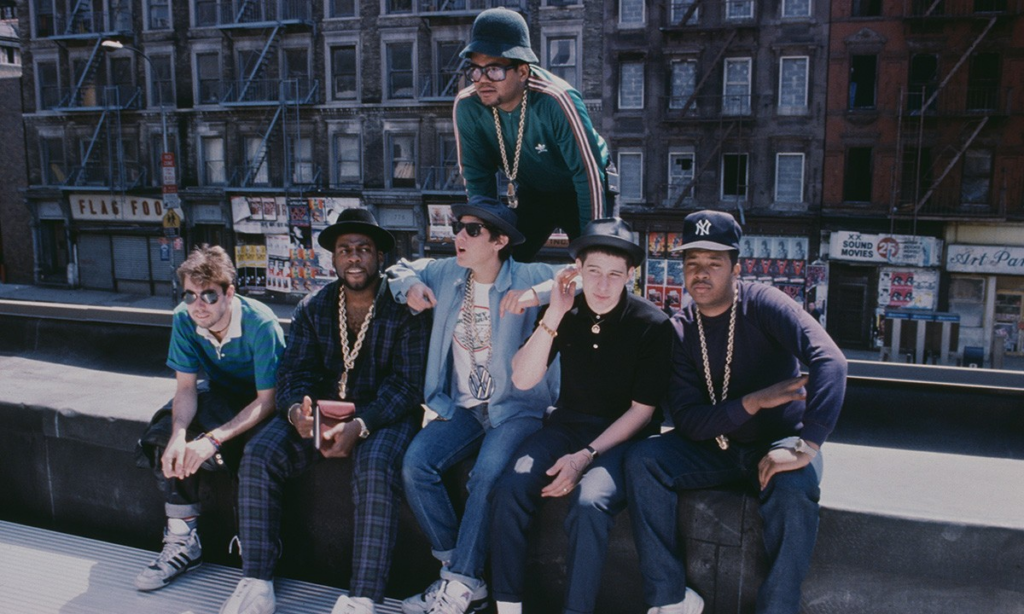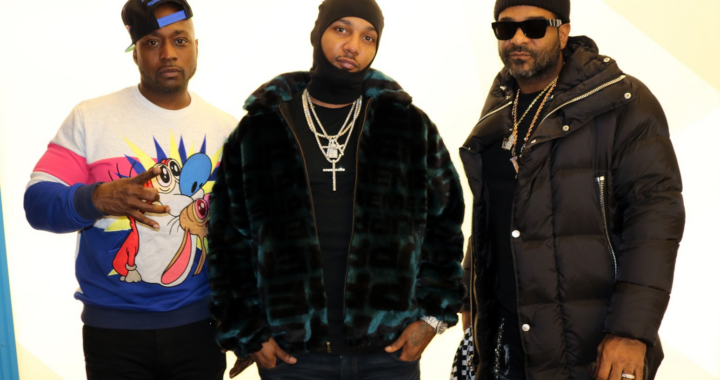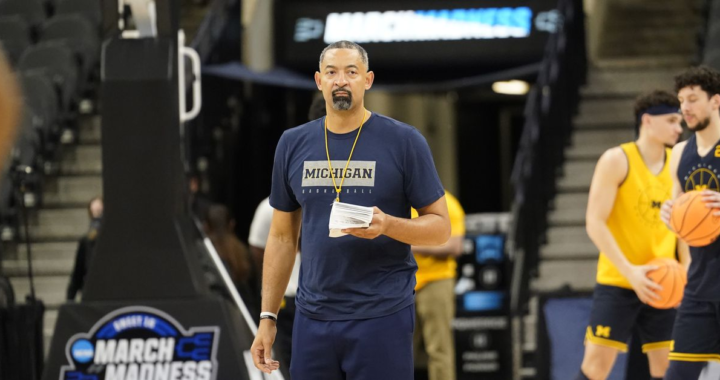A History of How Skinny Jeans Became Hip-Hop’s Denim of Choice
7 min read
Experience this story and others in HIGHEnergy, a print magazine by Highsnobiety, available from retailers around the world and our online store
Skinny jeans have always been as polarizing as they are narrow. Although they got their start with punk rockers like the Ramones and rock n’ roll sex symbols like Iggy Pop, it was within the hyper-masculine world of hip-hop that the pant began to challenge traditional notions of toughness. While the skinny was present during hip-hop’s glam-tinged genesis, it was the baggy “roughneck” style that dominated during the 1990s and became synonymous with the genre. When a new generation of rappers started wearing skinny jeans in the mid ’00s, it not only changed the history of denim’s imprint on hip-hop style, but also how men could express themselves at large. What was once the subversive, gender-bending uniform beloved by the underground and sneered at by OGs, has become a wardrobe staple for mainstream rappers today.
So what is the secret of the skinny’s success, and how did it wind up on top?

1982: When Grandmaster Flash and the Furious Five released their magnum opus, “The Message,” the cover came with a photo of the South Bronx group dressed in slender-cut jeans and shiny leather pants. The style reflected a moment of transition between the glam-rock decoration of the mid ’70s and 1980s athleisure. Taking cues from the downtown punk scene and their slim, leather-clad looks, the group represented an exciting fusion: part glam-drama, part biker gang, part ’80s pop opulence. Whether in denim, leather, or suede, the Furious Five liked their trousers tight.

1988: As hip-hop evolved as an art form and spread around the country, the glam-inspired uniforms associated with Grandmaster Flash and the Furious Five shifted to reflect the everyday uniforms of the teens and young adults who were intrinsic to the culture. Photographer Jamel Shabazz’s street snaps of 1980s Brooklyn capture how jeans and denim trucker jackets provided an authentic contrast to showy performance wear — reinforcing the reality behind the music, the places it was consumed and increasingly produced. At the same time, acts like Beastie Boys and Public Enemy’s Chuck D took what was happening in rock and channeled it through the filter of hip-hop by mixing slim jeans over high tops.

2007: Sir Michael Rocks and Chuck Inglish of The Cool Kids are widely credited with kickstarting rap’s skinny jean renaissance in the mid 2000s. It was this underground duo who paved the way for the Cudis, Chances, and Young Thugs of today with their loose, goofy, self-empowering brand of hip-hop — dubbed at the time “hipster hop.” The Chicago natives introduced retro vintage style like snapbacks, American Apparel–type stripe tees, and, of course, their brightly colored skinnies. What’s more, they made 2000s sneakerhead culture an integral part of hip-hop, rocking the SBs and Jordans that would influence everyone from A$AP Mob to Odd Future.

2008: While they may not be considered skinny in comparison to today’s spray-on pants, Pharrell was an early adopter of slim-fit jeans when wide cuts and sagging was at its peak. It was around this time Pharrell segued out of his baggy BBC and BAPE jeans to switch it up with slender styles teamed with tight SpongeBob SquarePants tees and white-rimmed glasses — no doubt a nod to the nu-rave scene happening in East London at the time. Andrew Luecke, author of Cool: Style, Sound, and Subversion, sees the current skinny jeans trend in hip-hop as a direct lineage from skateboarding in the 2000s. He cites skaters Jim Greco and Andrew Reynolds as influencing artists like Pharrell, who brought the new aesthetics of skating into hip-hop.

2009: When SoCal rap group New Boyz dropped their album Skinny Jeanz and a Mic, the release opened with the track “Cricketz,” which addressed the controversy that surrounded their bright neon and checkered skinny jeans. “Jeans / stay skinny like I starve my fabric,” Legacy raps. “Aye another damn thing / You’ll never see me care about another man’s jeans.” The line was a response to Jay-Z’s attack on his 2008 track “Swagga Like Us,” where he rapped, “Can’t wear skinny jeans ’cause my knots don’t fit … So I rock Roc jeans ’cause my knots so thick.” Baggy had been de rigueur in hip-hop for so long it was easy to forget that 25 years prior rappers had proudly worn tight denim.

2009: While Kanye West claimed he “made it so we could wear tight jeans” in a 2016 Twitter battle with Wiz Khalifa, he certainly wasn’t the first in his peer group to wear tight trousers. But West was right to contend that he made skinny designer denim ubiquitous. It was Ye, after all, who stormed Taylor Swift’s 2009 VMAs speech wearing a pair of Balmain biker jeans. In 2010, he introduced the rap world to Hedi Slimane’s Dior Homme denim line on the track “Christian Dior Denim Flow” — a song that represents the tipping point for male rappers dropping baggy fits in favor of something narrower.

2010: In May 2010, Bay Area rapper Lil B The BasedGod tweeted, “my pants are so tiny I shud be awarded….. I’m wearing ass jeans so tiny I cudnt zip them up. TINY PANTS MOB.” His penchant for skinny fits had come after his departure from The Pack, the rap group known for their baggy fits and Vans. The BasedGod loved skinny jeans so much he dedicated a whole track to them in 2012, a snapshot of his off-the-wall brand of allyship alluding to the homophobia that often clung to said pants within hip-hop at the time. “Tiny Pants yeah, and I’m riding on a full tank / Bulletproof vest, purple jeans looking fruity,” is one of the track’s less salacious lines.

2011: Some rappers go through a style evolution. Some go through a pure sartorial metamorphosis, channeling a different vibe entirely. Platinum-selling Grammy winner Lil Wayne underwent the latter. When Weezy got into skating in 2010, we witnessed a transformation from Magnolia Projects chic to SoCal skater. By 2011, Wayne had reached peak rock star when he hit the VMAs stage in a pair of women’s leopard print jeggings from Tripp NYC. (This same year even OG rapper Jay-Z wore slim jeans right along with everyone else — despite his lyrical assertion to the contrary.)

2014: When Kid Cudi released his breakout hit “Day ‘N’ Nite” in 2008, it not only created a new genre blending electronic indie music with hip-hop that would become a cornerstone in modern rap, but produced an amalgamation of sartorial styles. In the track’s video, Cudi appears dressed in skinny brown jeans, leather jacket, and beanie, a signature look from the house indie scenes at the time. Fast-forward to 2014 and skinnies were still a mainstay in Cudi’s wardrobe. The outfits he wore during two weekend performances at Coachella that year became a benchmark for men’s fashion. The first was a pair of dusty stone-washed skinny denim shorts worn with a vintage cherry-red crop top. The second was an artfully distressed pair of jeans worn with a vintage T-shirt.

2015: By the mid-2010s, the new guard of hip-hop style led by Theophilus London, Travis Scott, and A$AP Rocky began pushing a second wave of genre- and gender-bending fits. For a second, Balmain’s waxed biker jeans were all the rage. Next, it was all about extremely skinny cuts and chain-embellished denim from Saint Laurent, much like those worn by Young Thug at a 2016 VFILES show. While jeans had gotten tighter, they evolved with longer lengths that allowed them to be stacked and become baggy at the ankles, offering some added texture to the ultra-tight look.
2017: After a decade-long reign, the skinny reached its peak in 2017. No longer a symbol of subversion, the skinny’s place in mainstream rap was secured by Mike Amiri’s infamous ripped jeans — a staple for acts like Migos, 21 Savage, and Lil Uzi Vert. While Amiri’s designs might have all the hallmarks of traditional rock ’n’ roll style — such as rips, bandana patches and chain embellishments — he doesn’t see his design aesthetic connected to the genre of music itself, but rather the modern rock stars of today. It was during this time the skinny became even tighter (with more distressing) and often paired with chunky sneakers like Balenciaga’s Triple-S or Yeezy military boots.

2019: The roots of sagging pants can be traced back to the baggy fits of ’90s hip-hop, but throughout the mid 2010s, Chicago drill rappers like Chief Keef and Fredo Santana evolved the look with slimmer jeans worn stacked at the ankle. The trend is still very much alive thanks to rappers like 22Gz or Sauce Walka, who often wear low-riding fits with B.B. Simon belts as a homage to ’00s-era rappers like Max B, Jim Jones, and Juelz Santana.
2021: Today’s nostalgia-driven trend cycles have seen rappers return to classic wide-leg ’90s fits that Tupac would have approved of. But for acts like Playboi Carti and Lancey Foux, who lean on the edgy punk and gothic styles of late rock stars like Dave Vanian and Sid Vicious, the skinny remains an essential item. These aren’t the typical stonewash jeans you’d expect from rebel bands like The Ramones, but rather the sleek designs of brands like 1017 ALYX 9SM or Rick Owens who have rendered skinny fits in premium leather or resin coatings to make them appear like leather.
Order HIGHEnergy, a magazine by Highsnobiety, via our online store.






